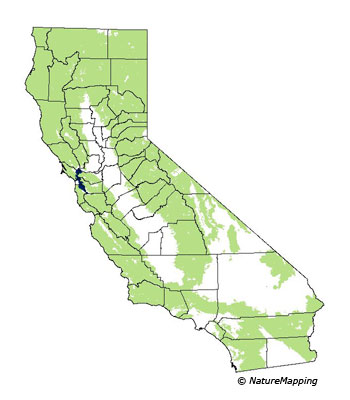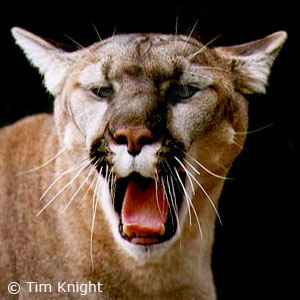
Home | About Us | Projects | Maps

Home | About Us | Projects | Maps
|
Cougar (Puma concolor) 
Cougars, also known as mountain lions or pumas, are native to California. Description: Cougars are carnivores. They are elusive, secretive animals rarely seen in the wild. Although their usual prey is deer and other wildlife, it is possible, although rare, for them to perceive humans as prey. 
The animal is identified by its large size, cat-like appearance, uniformly gray to reddish-tan body color, and long tail - nearly three feet (1 m) long and a third of its total length. The muzzle and chest are white and there are black markings on the face, ears and tip of the tail. Cougar kittens are mottled with black spots and have ringed tails until they are about 6 months old. The cougar is the second largest cat in the New World. (The jaguar is the largest.) An adult cougar can range in length from 42 to 54 inches, with a 3-foot-long tail. Adult males weigh up to 200 pounds, and adult females up to 120 pounds. Like all members of the cat family, cougars have five digits on the forepaw and four on the hindpaw. Each digit is equipped with a claw, which the cougar sheathes while walking, but which it uses with deadly effectiveness when grasping its prey. The front feet and claws are larger than their counterparts in the rear - adaptations for clutching large prey. 
Distribution: Other than humans, cougars are the most widely distributed land mammal in the Western Hemisphere. Cougars range from northwestern Canada to Patagonia, South America. Click on a range map to see where cougars live in California. Habitat: Cougars normally are reclusive animals which avoid humans. They make their dens in rocky outcroppings, dense thickets and under uprooted trees. They are highly territorial— a male cougar may dominate a home range of 50 to 150 square miles (for comparison, the City of Seattle is 92 square miles). Diet: Cougars are carnivores. Their main prey are different species of ungulates, including moose, elk, white-tailed deer, mule deer, and caribou in North America. They also eat smaller creatures like squirrels, muskrat, porcupine, beaver, raccoon, striped skunk, coyote, bobcats, other cougars, rabbits, opossums, birds, and even snails and fish. They may also prey on domestic livestock, including poultry, calves, sheep, goats, and pigs. (source: ADW) A male cougar living in the Cascade Mountains kills a deer or elk every 9 to 12 days. They eat up to 20 pounds of meat at a time then bury the rest for later. 
Reproduction and Development: Cougars begin breeding at about 3 years of age and may mate during any season. Typical litters of 1 to 6 kittens are born after a gestation period of 82 to 98 days. Their eyes open in 8 or 9 days and the young are weaned in 2 to 3 months, though the kittens may remain with the mother into their second year. Tracks: Cougar tend to leave "soft" tracks, meaning the animals make very little impact on the ground, and their tracks may be virtually invisible on packed earth. Cougars keep their claws retracted most of the time, which preserves sharpness, so claw marks are rarely visible in their tracks. The paw print can be visible in snow (see photo). Life Span: Male cougars can live 10 to 12 years in the wild. Females normally live longer than males.
NatureMapping - Project CAT (Cougars and Teaching)
Project CAT in designed to provide collaborative research on cougars in
rural and suburban settings to better understand cougar-human
interactions. K-12 students, teachers and local community members will
assist researchers in this extensive study of regional cougar
populations. Did you know?
Animal silhouettes available to purchase » Sources:
ADW: Puma concolor: Information
Cougars (Mountain Lions) - WDFW Living with Wildlife
Cougars in Mount Rainier National Park
Hinterland Who's Who - Cougar
Mountain Lion Tracks and Sign
Animal Track - Mountain Lion Tracks (Cougar) |